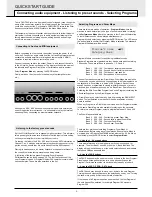
The Mixer
To extend the range of sounds that may be reproduced, a typical
Analogue synthesizer often has more than one Oscillator. By using more
than one Oscillator when creating a sound, it possible to achieve very
interesting harmonic mixes. It is also possible to slightly detune individual
Oscillators against each other which creates a very warm ‘fat’ sound.
There are has three independent Oscillators and a separate Noise
Oscillator.
The mixer section is included so that the amplitude (volume level) of each
of these Oscillators and Noise sources may be independently adjusted
and mixed together to form a new more harmonically complex waveform.
As well as mixing together the individual Oscillators as shown in the dia-
gram above, the mixer section allows the relative volume levels of the
Noise Oscillator and any external sound source to be set.
The Filter
The KS 4 / KS 5 is an
Analogue subtractive
type of music synthesizer.
Subtractive
implies that part of the sound is subtracted somewhere in the
synthesis process.
The Oscillators provide the raw waveforms with plenty of harmonic con-
tent and it is the
Filter
that subtracts unwanted harmonics in a controllable
manner.
Three types of Filter are available. The type of Filter most commonly
found on synthesizers is the Low Pass type. With a Low Pass Filter, a cut-
off point is chosen and any frequencies below that point are passed. Any
frequencies above are filtered out. The setting of the FREQUENCY knob
on the front panel dictates the point below which frequencies are
removed. This process of removing harmonics from the waveforms has
the effect of changing the sound’s character or timbre. When the FRE-
QUENCY knob is set fully clockwise, the filter is set completely open and
no frequencies are removed from the raw Oscillator waveforms.
In practice, there is a gradual reduction in the volume of the harmonics
above the cut-off point. How quickly these harmonics are reduced in vol-
ume above the cut-off frequency is determined by the Filter’s slope. This
slope is measured in ‘volume units per octave’. Since Volume is meas-
ured in decibels, this slope is quoted in number of decibels per octave
(dB). Typical values are 12dB or 24dB per Octave. The higher the num-
ber, the faster the harmonics are cut and the more pronounced the filter-
ing effect.
The button on the sectionl marked SLOPE allows either the 12dB or 24dB
type filter slope to be selected.
A further important feature of the Filter is the RESONANCE control.
Frequencies at the cut-off point may be increased in volume by this con-
trol. This is useful for emphasizing certain harmonics of the sound.
As the RESONANCE is increased, a whistling like quality will be intro-
duced to the sound passing through the filter. When set to very high lev-
els, RESONANCE actually causes the filter to self - oscillate whenever a
signal is being passed through it. The resulting whistling tone being pro-
duced is actually a pure sine wave, the pitch of which depends on the set-
ting of the FREQUENCY knob (the filter’s cut-off point). This resonance-
produced sine wave can actually be used for some sounds as an addi-
tional sound source if desired.
The diagram below shows the response of a typical low pass filter.
Frequencies above the cut off point are reduced in volume.
SYNTHESIS TUTORIAL
The Mixer - The Filter
•
11
•
OSC 1
OSC 1 VOLUME
OSC 2 VOLUME
OSC 3 VOLUME
COMPLEX
WAVEFORM
MIX OF
OSC1, 2 AND 3
MIXER
INPUT TO
FILTER
OSC 2
OSC 3
OSC 1
OSC 2
OSC 3
OSC 1 VOLUME
OSC 2 VOLUME
OSC 3 VOLUME
MIXER
INPUT TO
FILTER
COMPLEX
WAVEFORM
MIX OF
OSC1, 2 & 3
Frequency
Volume
Cutoff
Frequency
Volume
Frequency
Cut off
frequency











































